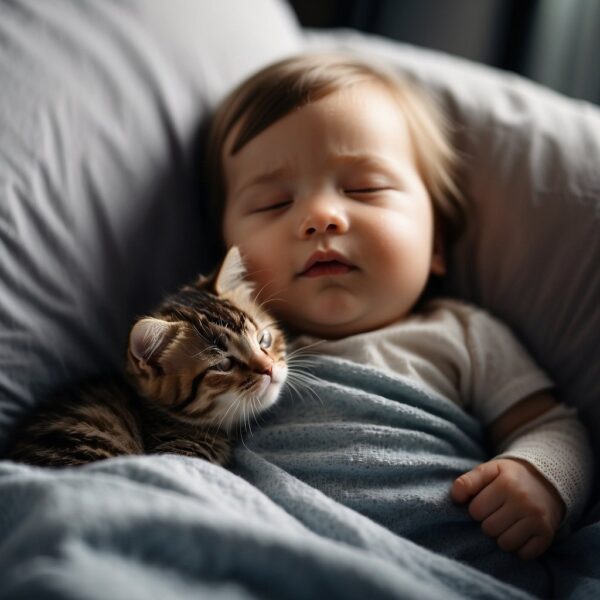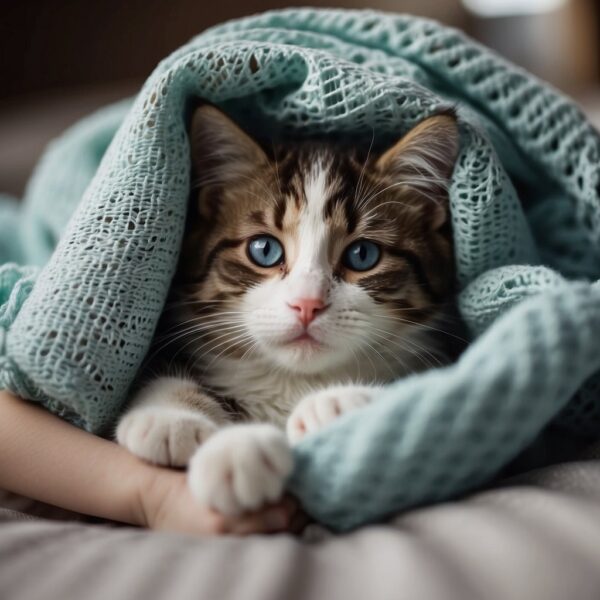
Cats Steal Baby’s Breath Myth debunked
The belief that cats can steal the breath of babies is a persistent myth with deep historical roots. Fear and misunderstanding of cats’ behaviors, especially around infants, have fueled this legend over time. The premise of the myth is that a cat, drawn by the smell of milk on a baby’s breath, would inadvertently suffocate the child while attempting to get close. Though widely circulated, this tale lacks scientific support and is not backed by any verifiable incidents.
Understanding cat behavior and maintaining proper infant safety can prevent any potential risks to babies in households with pets. Cats are naturally curious creatures and might be attracted to an infant’s crib out of curiosity. However, scientific explanations for the supposed behavior do not correlate with the myth’s claims. Education on pet management around young children and debunking misconceptions are key in altering public perception and reducing the social impact of such myths.
Key Takeaways
- The myth that cats can suffocate babies by stealing their breath is unfounded in science.
- Proper understanding of cats and vigilant management of infants around pets enhance safety.
- Addressing common misconceptions can shift public perception and minimize the myth’s influence.
Origins of the Myth that Cats steal babies breath
The belief that cats can steal a baby’s breath has long-standing historical roots, with superstition often intertwining with observations of feline behavior.
Historical Perspectives
Historically, cats have been both revered and feared, leading to various myths surrounding their nature. The myth that cats can suck the breath out of infants likely arose from observations of cats lying close to babies’ faces, possibly attracted by the smell of milk. In an era where infant mortality was poorly understood, any unusual behavior witnessed near a deceased child could give rise to superstitions.
Black Cats and Superstition
Black cats, in particular, have borne the brunt of superstitions, often associated with witchcraft and bad luck. This stems from medieval beliefs, especially in Europe, that witches could transform into black cats. Thus, a black cat near a baby would have been met with suspicion and fear. Superstitions around black cats have also been recorded in publications like the “Annual Register” and documented in colonies such as Plymouth, where pilgrims held strong beliefs about signs and omens.

Scientific Explanations debunking cats steal babies breath
In addressing the myth that cats can steal a baby’s breath, scientific investigations focus primarily on Sudden Infant Death Syndrome (SIDS) and the potential risks associated with cats being close to sleeping infants.
Sudden Infant Death Syndrome (SIDS)
Sudden Infant Death Syndrome, commonly referred to as SIDS or crib death, involves the unexplained death of an otherwise healthy infant, usually during sleep. The Centers for Disease Control and Prevention (CDC) classifies SIDS as a leading cause of death for infants aged 1 month to 1 year. While the exact causes of SIDS are still unknown, research has identified sleep environment factors that may increase the risk.
Cats, Babies, and Suffocation Risks
Experts acknowledge cats’ natural curiosity and their tendency to seek warm places, which could lead them to sleeping babies. However, there is no evidence to support the claim that a cat is capable of intentionally suffocating a baby by smothering or strangulation. Instead, the coroner and authorities would investigate environmental risks and evidence of potential accidental suffocation. Parents are encouraged to maintain a safe sleep environment for infants, keeping the crib free from objects, including pets, which pose suffocation risks.
Understanding Cat Behavior
In unraveling the myth that cats steal a baby’s breath, it’s critical to examine feline behavior, particularly in relation to their interaction with humans and infants.
Cats’ Pheromones and Intentions
Cats communicate through pheromones, chemical substances that convey specific messages to other cats and can influence a cat’s behavior. When a cat rubs against a person or object, it is depositing these pheromones to mark territory or express comfort. Despite common misconceptions, these actions are not linked to any harmful intentions towards infants. Cats do not exhibit jealousy in the human sense, and any close interaction with babies should be interpreted with this understanding.
Cats and Cuddling Behavior
Cats naturally seek out warmth and security, which often leads them to cuddle up in cozy spaces. A baby’s crib can provide such an environment, which may encourage a cat to snuggle close. It’s the purr and nuzzle of a cat that signals contentment, not a pursuit to do harm. While it’s crucial to supervise interactions and ensure the safety of infants, the attention cats may show is typically a benign desire for comfort and companionship, rather than an obscure intent as the myth suggests.

Infant Safety and Pet Management
Ensuring the well-being of infants in homes with pets requires diligent safety measures and responsible pet management. Below are specific strategies for creating a secure environment for newborns and appropriate pet training to maintain awareness around infants.
Safety Precautions in Homes with Newborns
When introducing a newborn into a home with pets, it is crucial to implement safety precautions. Safety around the crib should be a priority. Parents and guardians should consider the following measures:
- Maintain a Clean Environment: Regularly sanitize surfaces and wash hands to reduce the potential for bacteria transmission from pets.
- Secure the Crib: Prevent pets from entering the crib by using a crib tent. This can protect the infant from accidental smothering while maintaining airflow.
- Limit Pet Access: Restrict pets from the baby’s sleeping area to avoid any incidents, especially when the baby is unsupervised.
Pet Training and Awareness
Proper pet training and awareness are essential to prevent accidental harm to infants. Cat parents should ensure their cats are well-trained and knowledgeable about how to behave around newborns.
- Behavioral Training: Teach cats to keep a safe distance from the baby’s area and not to jump or climb into the crib.
- Health Management: Keep cats healthy and vaccinate them to minimize the risk of disease transmission. Pregnant women should specifically avoid handling the litter box due to the risk of toxoplasmosis.
- Supervised Interaction: Always supervise any interaction between cats and infants to intervene if necessary and to teach the cat appropriate behavior around the baby.
Misconceptions about cats stealing babies breath
In addressing the misconception that cats can steal a baby’s breath, it is crucial to distinguish between myths and verifiable facts. The spread of such fallacies, often amplified by the internet, has exacerbated fears among parents and pregnant individuals.
Myths vs. Facts
Myth: Cats suffocate babies by stealing their breath.
Fact: There is no scientific evidence that cats can or want to “steal” a baby’s breath. This is a false belief rooted in old wives’ tales.
- Myth: Cats are attracted to a baby’s milk breath and may harm them as a result.
- Fact: Cats may be drawn to the warmth of a sleeping baby, but they do not harm them with the intention of stealing their breath.
Role of the Internet and Information Spread
- Dissemination of False Information: The internet can rapidly spread misinformation, causing misconceptions about cats and babies to persist.
- Correcting Misconceptions: Reliable internet sources and expert advice can help dispel fears by providing factual information regarding the safety of having cats around babies during pregnancy and afterwards.
The internet wields power in forming public perceptions, and its role in the propagation or correction of misconceptions regarding cats and babies is significant. Accurate knowledge can alleviate undue fear and prevent the spread of unfounded myths.
Public Perception and Social Impact of the myth that cats steal babies breath
The misguided belief that cats can in some way harm infants by “stealing their breath” has permeated public consciousness, influencing both societal views of these animals and practical considerations regarding pet ownership.
Cats in Popular Culture
Cats have held various symbolic roles in popular culture, often associated with superstitions and myths. Black cats, in particular, are infamously linked to bad luck, which can affect people’s perceptions of them both negatively and positively. Within the realm of folklore, cats are sometimes unjustly portrayed as malevolent entities or omens of misfortune, which reinforces and propagates baseless fears.
Effects on Domestic Cat Adoption
This unfounded fear has tangible consequences, notably impacting domestic cat adoption rates. The perpetuation of the myth in question can discourage families, especially those with infants, from adopting cats. They might instead turn to perceived ‘safer’ pets like dogs. Animal shelters sometimes experience challenges in placing cats in homes due to such concerns, although these anxieties are not supported by scientific evidence. It’s important for adoption agencies and advocates to educate potential pet owners about the harmless nature of cats to help counteract these beliefs.

Frequently Asked Questions about cats stealing babies breath
This section addresses common inquiries surrounding the myth that cats can suffocate infants by ‘stealing their breath.’
What is the history behind the belief that cats can suffocate infants?
The myth dates back centuries and stems from a lack of understanding of infant mortality and cat behavior. It was once believed that cats were drawn to the milk on a baby’s breath and could inadvertently harm them.
Are there any documented cases where cats steal babies breath’?
There are no credible reports or documented cases that prove cats have suffocated babies by ‘stealing their breath.’ This belief is considered a myth.
What might cause a cat to be attracted to a sleeping baby’s face?
Cats may be drawn to a baby’s face due to the smell of milk or simply out of curiosity, but there is no malicious intent behind this behavior.
Is there scientific evidence to support or refute the claim that cats steal babies breath?
Scientific evidence refutes the claim that cats can suffocate babies. Studies have shown that the myth is unfounded and no causal relationship exists between a cat’s presence and infant suffocation.
Could certain behaviors in cats lead to misunderstandings about their intentions towards infants?
Certain feline behaviors, such as nuzzling or cuddling close to a baby, may be misinterpreted as harmful when they are typically expressions of affection or seeking warmth.
Are infants at risk from a cat’s presence in their sleeping environment?
While direct suffocation by cats is a myth, it is generally recommended that infants have a safe sleeping space without any pets to minimize any risks and ensure the baby’s safety.